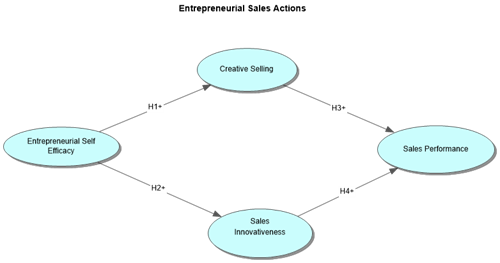
Issue 3 | Article 13
ABSTRACT
This article addresses the interrelationships between a business-to-business (B2B) salesperson’s sales performance and their level of entrepreneurial self-efficacy and entrepreneurial sales actions. The findings suggest that entrepreneurial self-efficacy strongly influences sales innovativeness and creative selling, highlighting the importance of senior management encouraging and rewarding new selling methods. These sales actions also positively and significantly impact individual sales performance. The author concludes that creative selling and sales innovativeness are powerful influencers of personal sales performance.
INTRODUCTION
This article examines the interrelationships between entrepreneurial self-efficacy (ESE), entrepreneurial selling actions, and individual business-to-business (B2B) sales performance. Earlier research into the antecedents of B2B sales performance explains only a small amount of the variances in performance (Bolander et al., 2015). The research has ignored the possible role of different entrepreneurship approaches in explaining and improving B2B sales performance. The purpose of this study is to explore the overall research question:
What are the interrelationships between individual sales performance in a B2B context and (i) entrepreneurial self-efficacy and (ii) entrepreneurial sales actions?
The prime role of the sales function is to generate revenue. Therefore, sales are a primary concern and priority for firms operating in competitive B2B markets. Consequently, entrepreneurship - which focuses on leveraging, advantage seeking, proactiveness, risk acceptance, and innovativeness to create and exploit attractive economic opportunities - has become a popular prescription for revitalising a firm’s business.
Early scholarly work suggested that marketing functions such as sales and entrepreneurship were interrelated. For example, Morris et al. (1990, p. 3) noted that while:
“...a growing body of anecdotal and empirical research substantiates the importance of entrepreneurship for established firms…such general findings provide little guidance in terms of the application of entrepreneurship to specific functional areas within firms. One of the most critical of these functions in today’s corporation is sales.”
Nevertheless, work by both marketing and entrepreneurship scholars on how an entrepreneurial perspective impacts the individual sales functional-level actions and performance remains minimal (Matthews et al., 2018).
Predicting B2B sales performance is complex. Much of the sales performance research to date has identified variables that account for only a small percentage of the variance (e.g., 10% to 20%) in B2B salesperson performance (Bolander et al., 2015). It is this gap that motivated the author to analyse and test the effects of entrepreneurship variables on B2B sales performance. Thinking and acting entrepreneurially within organisations have become essential requirements of senior management. In the context of investigating B2B sales performance, the ESE construct plays a crucial role in whether individuals engage in entrepreneurial behaviour and actions (Newman et al., 2019).
ESE refers to an individual’s belief in their capability to perform tasks and roles aimed at entrepreneurial outcomes (Zhao et al., 2005). Researchers have investigated the relationship between ESE and individual outcomes such as entrepreneurial intentions, emotions, and actions. However, very few ESE studies have focussed directly on sales performance (Newman et al., 2019).
This article seeks to explore the impact of entrepreneurship on sales by examining the relationships between ESE, entrepreneurial sales actions, and salesperson performance. It articulates how a B2B salesperson’s level of ESE may impact their implementation of entrepreneurial sales actions (i.e., creative selling and sales innovativeness) and, ultimately, their individual sales performance. Key entrepreneurial actions and activities typically used by salespeople in a corporate business environment include creative selling and sales innovativeness. Creative selling refers to the number and type of new ideas generated, as demonstrated by the salesperson (Wang & Netemeyer, 2004). Sales innovativeness is the flexibility and willingness to accept new problem-solving methods (Matsuo, 2009). Individual B2B sales performance can be based on objective financial measures, such as revenue, profit, and return on investment, as well as non-financial measures like customer satisfaction.
THEORETICAL FRAMEWORK
The following hypothesis were proposed:
-
H1. A positive relationship exists between entrepreneurial self-efficacy and creative selling.
-
H2. A positive relationship exists between entrepreneurial self-efficacy and sales innovativeness.
-
H3. A positive relationship exists between creative selling and individual sales performance.
-
H4. A positive relationship exists between sales innovativeness and individual sales performance.
Figure 1 illustrates the conceptualized relationships between the constructs in this study.


Figure 1: The Conceptual Model
RESEARCH METHODS
Sample
Data were collected from 252 B2B salespeople working in large Australian firms from June to September 2020. Participants responded to a 56-item online survey, and the results were analysed using Partial Least Squares – Structural Equation Modelling (PLS-SEM).
Instruments
A structured online questionnaire was used to gather data from the participants. The constructs were measured using a five-point Likert scale. ESE was measured by the Zhao et al. (2005) four-item scale. Creative selling was measured by the Wang and Netemeyer (2004) seven-item scale, while sales innovativeness was measured using the Matsuo (2009) six-item scale. Finally, the Jones et al. (2007) seven-item scale measured the individual sales performance.
RESULTS
Construct reliability and validity
All measures used in the study exhibited sufficient construct reliability. Convergent validity and discriminant validity for all constructs exceeded the acceptable levels. In addition, collinearity between the variables was well within the suggested acceptable range. Goodness of fit had satisfactory measurement properties, indicating a good fit between the data and the theoretical constructs.
Hypothesis testing
Based on the construct verification, PLS-SEM was used to examine the hypothesised direct paths. There was a positive and significant relationship between ESE and creative selling (β = 0.71, p-value < 0.01), supporting H1. There was also a positive and significant relationship between ESE and sales innovativeness (β = 0.61, p-value < 0.01), supporting H2. Furthermore, there was a significant and positive relationship between creative selling and sales performance (β = 0.42, p-value < 0.01), supporting H3. Finally, there was also a significant and positive relationship between sales innovativeness and sales performance (β = 0.21, p-value < 0.01), which supports H4.
Based on the results of the hypotheses testing, we can conclude that the overall model is significant and positive. Creative selling has high explanatory power (R2 = 0.51); sales innovativeness has medium to high explanatory power (R2 = 0.38); and individual sales performance also has medium to high explanatory power (R2 = 0.30). These results are important, since previous studies have found it difficult to explain more than 10% to 20% of the variance in a salesperson’s performance in (Bolander et al., 2015). The relationships are illustrated in Figure 2.

Figure 2: Path Model Results
DISCUSSION, IMPLICATIONS, LIMITATIONS, AND FUTURE RESEARCH
Discussion
Sales performance is an essential function of business. This study extends the literature by addressing and applying entrepreneurial theories and approaches to B2B sales performance. The results highlight the importance of identifying and developing ESE among B2B salespeople and creative selling and sales innovativeness to improve sales performance.
Theoretical implications
ESE positively and significantly influences both creative selling and sales innovativeness. Furthermore, these entrepreneurial sales actions directly and positively affect individual B2B sales performance. Establishing these relationships is a novel contribution to the marketing and sales literature as well as to the entrepreneurship literature.
This study also adds to the literature by looking at ESE and sales performance differently to earlier approaches. Previous studies focused on the firm level, while this research examined the constructs at the individual B2B salesperson level.
Finally, as stated earlier, even with extensive research, sales performance is a complex construct and is difficult to predict (Bolander et. al 2015). This study found that ESE and its relationship to creative selling and sales innovativeness accounted for 51% and 38%, respectively, of the total variation. It explains a significantly higher share of performance variation than has been reported in previous studies.
Managerial implications
The study should help management understand that salespeople who possess a higher level of ESE and use entrepreneurial sales actions will improve their B2B sales performance. It may also have implications for the overall strategic direction chosen by an organisation. For example, since the study finds that ESE has a positive impact on a salesperson’s actions and performance, senior management may wish to encourage an environment in which ESE behaviours are not only accepted but also encouraged. This may involve creating a workplace environment where salespeople are granted a high level of autonomy in their jobs and market and product ideas are frequently solicited from them. In addition, information sharing may be encouraged and supported both vertically and horizontally throughout the organisation.
Accordingly, top management should consider providing appropriate training and skills aimed at continuously fostering innovative and creative sales actions. This suggestion is in line with the view that senior executives should have relevant entrepreneurial skills; in their absence, employees’ entrepreneurial sales actions may be curtailed. At the same time, the organisation’s business model and strategic planning should include entrepreneurial actions.
The results of the study suggest that top managements that require their salespeople to behave within the “corporate guidelines” (i.e., take no or minimal risks) may be inhibiting their B2B salespeople from performing to their full entrepreneurial potential.
Finally, as far as entrepreneurial sales actions are concerned, senior management needs to recognise that these are not incremental innovation initiatives that involve mainly process improvement. Incremental innovations cannot withstand any significant market disruptions incurred through increased competition, technology changes, and liberalising trade policies. Given the significance of sales performance for their future prosperity, firms need to focus on building the capability and capacity of salespeople to innovate.
Limitations
The primary limitation that constrains this study’s generalisability is its use of a non-random judgment sample. A second limitation, due to time constraints, is its adoption of cross-sectional analysis. Third, the study did not analyse the potential roles of control variables (e.g., age, gender, size, industry, and tenure) on the overall sales performance relationship. Finally, the study did not assess the effectiveness of the various innovation and creative actions implemented by B2B salespeople during the period of the study.
Suggestions for future research
First, future research should encourage organisations and other job roles/functions to develop more robust empirical evidence of ESE and performance practices. This is important as the research suggests that ESE is positively related to entrepreneurial sales actions and individual sales performance.
Second, future research may benefit by using a longitudinal research design that extends the data collection period and allows for studying the full effects of entrepreneurial sales actions.
Third, factors other than those analysed in this study also influence B2B sales. Future research may better integrate the characteristics of costs, frequency, and risks, including the critical issues of performance risks and corporate social responsibility alignment issues.
CONCLUSION
This study underscored the imperative for the theories and practices of entrepreneurship to “work together” with those of sales. It demonstrated that adopting an ESE approach and encouraging entrepreneurial sales actions had a positive and significant effect on individual B2B sales performance.
REFERENCES
Bolander, W., Satornino, C. B., Hughes, D. E., & Ferris, G. R. (2015). Social networks within sales organizations: Their development and importance for salesperson performance. Journal of Marketing, 79(6), 1–16.
Jones, E., Chonko, L., Rangarajan, D., & Roberts, J. (2007). The role of overload on job attitudes, turnover intentions, and salesperson performance. Journal of Business Research, 60(7), 663–671.
Matthews, R. S., Chalmers, D. M., & Fraser, S. S. (2018). The intersection of entrepreneurship and selling: An interdisciplinary review, framework, and future research agenda. Journal of Business Venturing, 33(6), 691–719.
Morris, M., Avila, R., & Teeple, E. (1990). Sales management as an entrepreneurial activity. Journal of Personal Selling & Sales Management, 10(2), 1–15.
Newman, A., Obschonka, M., Schwarz, S., Cohen, M., & Nielsen, I. (2019). Entrepreneurial self-efficacy: A systematic review of the literature on its theoretical foundations, measurement, antecedents, and outcomes, and an agenda for future research. Journal of Vocational Behavior, 110(2019), 403–419.
Wang, G., & Netemeyer, R. (2004). Salesperson Creative Performance: Conceptualisation, Measurement, and Nomological Validity. Journal of Business Research, 57(8), 805–812.
Zhao, H., Seibert, S. E., & Hills, G. E. (2005). The mediating role of self-efficacy in the development of entrepreneurial intentions. Journal of Applied Psychology, 90(6), 1265–1272.
BIOGRAPHY

Dr John Edwards has over 35 years’ experience working in business and education industries. He was the Director of Corporate and Executive Education Director at Macquarie Graduate of Management (MGSM); held Marketing roles at Westpac, Citibank, Advance Bank, Diageo and Kellogg’s. He completed his Master of Research in 2015, and PhD (on Corporate Entrepreneurship and Sales Performance) in May 2022. He has published articles in the Journal of Business Research.




